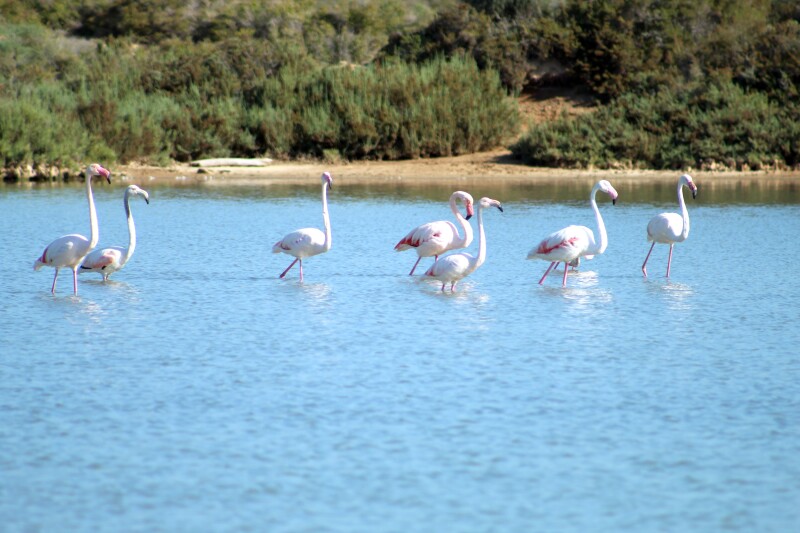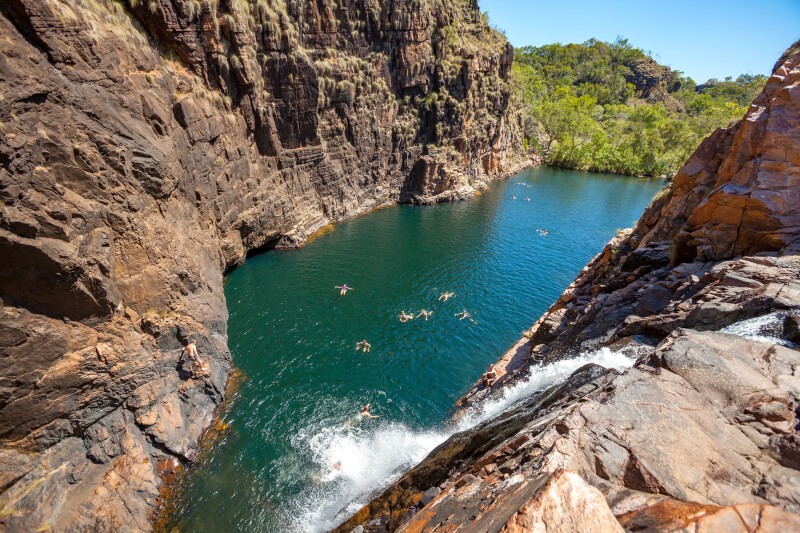For a location or landmark to attain UNESCO status, it needs to have serious special significance. There are three types of UNESCO World Heritage sites: cultural (e.g., the historic center of Vienna), natural (think Everglades National Park), and mixed, meaning humans inhabited or left a historical mark on the unique landscapes. The last category is the rarest; only 40 of UNESCO’s more than 1,200 sites have that dual status. That’s less than 4 percent of all UNESCO sites worldwide.
A few mixed sites are famous: Machu Picchu, Tikal, Cappadocia. Some are unexpected: Ibiza is more than Spain’s party island. Australia and China tie for the most—four each. And in the USA, the single mixed UNESCO World Heritage site is almost as hard to spell as it is to reach: Papahānaumokuākea, an archipelago of small islands in Hawai‘i. Others inaccessible to tourists include Serranía de Chiribiquete National Park in Colombia, the world’s largest protected tropical rainforest.
Several of these sites are very remote, which has helped them stay well preserved and free of crowds. Here are 12 of the most intriguing mixed World Heritage sites around the globe.
Hierapolis-Pamukkale, Türkiye
Who doesn’t enjoy soaking in hot springs? The Greeks and Romans certainly did; back around 130 B.C.E., the town of Hierapolis—in modern-day Türkiye—was a spa destination, and it would remain that way for several centuries. The main reason for that was the nearby thermal mineral waters of Pamukkale (cotton palace or cotton castle), with its bizarre landscape of terraced basins and petrified waterfalls. An extensive system of canals was built to bring the water both to the baths and village residents, and to fields for irrigation. The ancient amphitheater here, one of the best preserved in the world, was a venue for gladiator fights during its Roman era.

Hikers on the 12-mile Tongariro Alpine Crossing in Tongariro National Park can take a meditative pause at Blue Lake, formed by a volcanic crater.
Courtesy of Destination Lake Taupo
Tongariro National Park, New Zealand
One of three national parks on the North Island, Tongariro is also New Zealand’s oldest. Within its nearly 200,000 acres (312 square miles) are alpine lakes and three active volcanoes. For the Māori people, the park’s mountains are rich in mythology. The 12-mile Tongariro Crossing hike is considered one of the world’s best day hikes, thanks to its views of Mount Tongariro and Mount Ngauruhoe volcanoes. Also in the park: Mount Ruapehu, the country’s largest active volcano and the North Island’s high point at 9,177 feet. All three volcanoes have erupted in the past 50 years.

The Blue Mountains offer more than coveted coffee beans.
Photo by Marc Stephan/Shutterstock
Blue and John Crow Mountains, Jamaica
Coffee cultists associate this Caribbean island’s Blue Mountains with the source of rare, pricey beans. For UNESCO, these lands are notable for biodiversity (well over 1,200 species of flowering plants), endangered frogs and birds, and as a historical refuge for the enslaved Maroon people. The rugged landscape, which forms a national park, provided the Maroons with a suitable place to hide and develop a culture closely connected to mountain life. Several tour operators run hiking trips or tours to coffee farms.

Boat tours around Trang An will take you inside its caves.
Photo by Dong Nhat Huy/Shutterstock
Trang An Landscape Complex, Vietnam
Forested limestone rock towers reach as high as 650 feet throughout this area, and there’s evidence that people lived in the elevated caves here long ago. Situated near a river delta, Trang An also includes a network of subterranean waterways, accessible to visitors by small-boat tours. Today, aside from villages, rice paddies, temples, and a few small tourist resorts, the landscape remains in its natural, dramatic condition—one of the reasons 2017’s Kong: Skull Island was filmed here.

Bird lovers flock to the Ses Salines Natural Park in Ibiza.
Photo by Wanderlust Media/Shutterstock
Ibiza, Spain
This island, hardly a secret vacation spot, is better known for its nonstop nightlife than its nature. But UNESCO has recognized it for its culture and biodiversity for more than 25 years. Various cultures have visited this Balearic isle over the centuries, including the ancient Phoenicians, who had a colony here. Remains of their presence include a well-preserved necropolis. A highlight of Ibiza’s biodiversity is Ses Salines Natural Park, noted for its marine life; it’s ideal for watching flamingos and snorkeling.

Wildlife and fossil remains are among the attractions at Ngorongoro Conservation Area.
Courtesy of Dmitrii Zhodzishskii/Unsplash
Ngorongoro Conservation Area, Tanzania
Adjacent to famed Serengeti National Park, this natural/cultural site includes Olduvai Gorge, which has long been an area of archaeological research and is rich in fossil records of our human ancestors. It also features the world’s largest unbroken volcanic crater and supports a wide range of wildlife, including major migrations of zebras, gazelles, and wildebeest. Semi-nomadic Maasai continue to use the land for cattle grazing.

Overlooking Lake Ohrid is the Macedonian Orthodox Church of Saint John at Kaneo, believed to date from the 13th century.
Courtesy of Franx'/Flickr
Natural and Cultural Heritage of the Ohrid Region, Albania & North Macedonia
The natural aspect of this site—Lake Ohrid—straddles the border of these two countries, while the cultural part—the old town of Ohrid—is in North Macedonia. Both are far from well-trod paths. This scenic and historic spot includes one of Europe’s oldest and deepest lakes as well as one of its oldest human settlements. It’s also home to St. Panteleimon, the most ancient Slav monastery, plus remains of 4th- to 6th-century Christian churches and basilicas noted for their mosaic floors. Extensive frescoes and more than 800 Byzantine-style icons in Ohrid date from the 11th through the 14th centuries. The geographic isolation also means the lake is a fine place for bird-watching.

Visitors are dwarfed by the Leshan Giant Buddha.
Photo by Keitma/Shutterstock
Mount Emei Scenic Area, including Leshan Giant Buddha Scenic Area, China
No one can say that this popular tourist site is not packed, as it’s less than three hours by car from Chengdu. It’s actually two sites in one, Leshan and Emei, which are separated by a two- to three-hour drive (depending on traffic). All of China’s mixed sites involve mountains, but only Leshan in Sichuan Province offers the world’s largest Buddha sculpture (233 feet tall) carved into a hillside. That’s fitting, since this is where Buddhism was introduced to China. The hills and cliffs also feature many historic temples. Evergreen forests and three rivers enhance the setting. And as one of China’s four sacred Buddhist mountains, Emei has long been protected; sitting atop its summit is one of the first Chinese Buddhist temples, dating from the 1st century C.E.

After hiking and admiring Aboriginal rock art in the caves of Kakadu National Park, cool off in Maguk, a natural pool.
Photo by Umomos/Shutterstock
Kakadu National Park, Australia
Australia’s second-largest national park, located in a tropical stretch of the Northern Territory, encompasses portions of four river systems, waterfalls, wetlands, and steep cliffs and plateaus inaccessible to vehicles. The thousands of sites of rock art and cave paintings make clear that Aboriginal people have lived here for some 40,000 years, and continue to do so today. Crocodiles, wallabies, and flying foxes also live here, and a large and diverse bird population makes it a prime place for bird-watching. It’s often hot here, but cooling off in a natural rock pool like Maguk or Gunlom (featured in Crocodile Dundee) provides some respite.

The rock monument La Theiere (the Teapot) is one of many impressive sights in this Algerian spot.
Photo by Klara Bakalarova/Shutterstock
Tassili n’Ajjer, Algeria
Nature and culture mix vividly at this site in remote southeastern Algeria, which offers an impressive array of prehistoric cave art in a landscape of eroded sandstone pillars and arches in the desert. The engravings and paintings, rediscovered in the 20th century, include images of animals; they range over 10,000 years and show species that have long been extinct in the region, such as crocodiles and hippopotamus. They also depict how a society and the climate evolved.

The Bloodvein River, one of several in Pimachiowin Aki, gets its name from red rocks; some feature ancient drawings.
Photo by Dustin Silvey
Pimachiowin Aki, Canada
Meaning “The Land That Gives Life” in the Ojibwe language Anishinaabemowin, this site in Canada is the traditional home of four Anishinaabe First Nations communities. In this boreal forest rich with lakes and rivers in the provinces of Manitoba and Ontario, caribou, wolverines, moose, and other wildlife flourish. The local First Nations communities follow their long cultural tradition of “keeping the land,” a stewardship that includes regulated fishing and hunting, maintaining ancient and sacred spaces, and avoiding commercial development.

Walls and shelters on remote St. Kilda testify to its long habitation.
Photo by IrenicRhonda/Shutterstock
St. Kilda, United Kingdom
Among nearly three dozen U.K. UNESCO sites, St. Kilda is the only mixed cultural-natural site; it’s also one of the most remote. Yet this small archipelago off Scotland’s west coast was inhabited for thousands of years. (No one lives there now, except for a million visiting seabirds and feral sheep.) The striking landscape results from the islands’ formation by a volcano. St. Kilda’s high sea cliffs and sea stacks experience some of the tallest waves and strongest winds in Europe.
This article was originally published in 2021 and most recently updated on June 9, 2025, with current information.











